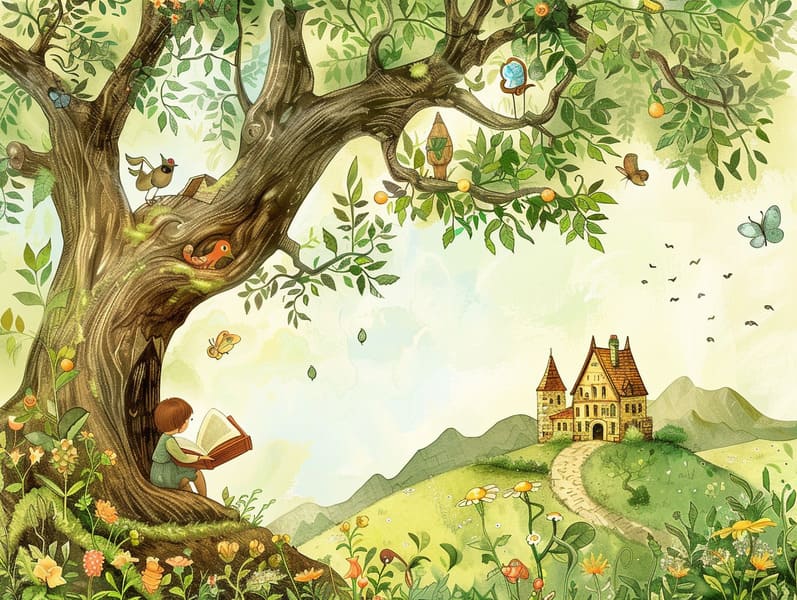
Classic fairy tales have historical significance. These tales have been whispered from one generation to the next millennia before they were ever inscribed. They arose from a variety of civilizations, including Asian traditions. They were initially conveyed among grown-ups, often carrying themes and messages relevant to the societal norms and beliefs of the time.
The renowned Brothers Grimm, Jacob and Wilhelm (the Grimm brothers), were among the first to assemble many of these beloved tales. Their collection, "Grimm's Fables," included tales like "The Little Glass Slipper," "Hansel and Grethel," and "Schneewittchen," which have since become cornerstones in the world of beloved fairy tales. Similarly, Hans Andersen's magical narratives, such as "The Mermaid's Tale," and "The Ugly Duckling," have touched hearts worldwide, cementing their place in the pantheon of beloved fairy tales.
Even though they are old, fairy tales remain as significant as ever, especially as bedtime stories for kids. These enchanting tales are now available in many formats, including vibrantly illustrated books, magical animations, and online storybooks.
Their enduring popularity can be credited to several charming aspects:
Key Lessons: Ancient fairy tales often present important moral lessons. Stories like "The Tale of the Boy Who Cried Wolf" teach the significance of integrity, while "The Tortoise and the Hare" emphasize the traits of persistence and humility. These narratives offer young ones clear distinctions between virtue and vice, building their moral compass in a gentle yet meaningful way.
Empathy and Awareness: Traditional fairy tales frequently present beings facing challenges and struggles, stimulating young readers to resonate with their struggles and support their triumphs. For instance, "The Tale of Beauty and the Beast" emphasizes the significance of looking beyond appearances to see the inner being of a character, enhancing compassion and recognition.
Cultural Insights: Many traditional fairy tales are deeply embedded in the cultural contexts from which they arose. Reading these tales can provide illuminating insights into different ways of life, strengthening a sense of cultural insight and respect.
Imagination and Innovation: The supernatural elements in timeless fairy tales—mythical creatures—provoke children’s fantastical thinking. These fairy tales bring readers to extraordinary realms, unleashing innovative dreams and a sense of marvel that persists a lifetime.
Ancient fairy tales are not only fascinating but also instructive. They serve as enchanted tools in nurturing various cognitive and affective skills in young readers. When old fairy tales are told out loud, they promote communication skills by introducing new phrases and sophisticated sentence structures. This practice also cultivates listening skills and attentiveness, as young readers pay close attention, enthusiastic to see what happens next.
Furthermore, debating the themes and characters of timeless fairy tales can nurture analytical skills and critical thinking. Little ones are educated to spot patterns, anticipate outcomes, and comprehend cause and effect. These reflections also facilitate the young verbalize their thoughts and feelings, enhancing their emotional intelligence.
In today’s digital era, the presence of online fairy tales has made these tales more reachable than ever. Web platforms and digital apps present wide arrays of bedtime fairy tales that can be perused or listened via anytime, anywhere. Fairy tales voiced are particularly popular, providing an interactive method for children to relish these charming stories. Audio stories and read-to-me stories move characters and settings to life, often enhanced by magical music and background music that heighten the tale journey.
The lasting appeal of old fairy tales lies in their ability to change to contemporary times while continuing with their key morals. Contemporary adaptations of these tales often introduce more multicultural characters and modern settings, making them pertinent to today’s audience. However, the key lessons of braveness, understanding, and rightness remain unchanged, continuing to strike a chord with audiences of all ages.
Traditional fairy tales also offer a sense of ease and knownness. They yield a well-arranged narrative with a recognizable beginning, middle, and end, often coming to a close with the closure of conflicts and the triumph of good over bad. This consistency can be reassuring for children, spreading a sense of consistency in an unstable world.
Old fairy tales continue to spellbind and enlighten new generations, maintaining their charm and impact in modern society. As kids' bedtime tales, they present to a perfect blend of wonder and wisdom, enriching moral values, empathy, and creativity. The existence of online fairy tales and the well-received status of fairy tales narrated warrant that these timeless fairy get more info tales remain obtainable to new generations.
By maintaining and telling these stories, we continue to appreciate the rich tapestry of inventiveness and cultural heritage. Whether you are enjoying a beautifully illustrated book, perusing a digital collection, or playing an sound book, the loveliness of famous fairy tales is always within reach. These narratives illustrate of the immortal spell of stories and its ability to draw us together across eras and regions.
Be it you are seeing a vividly illustrated book, experiencing a electronic collection, or playing an sound book, the grace of ancient fairy tales is always within reach.
These stories reveal of the enduring essence of stories and its ability to bring us together across eras and regions, forming a connection that captivates and teaches alike.
Comments on “Tracing the Heritage of Traditional Fairy Tales with Its Eternal Charm.”